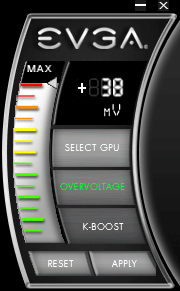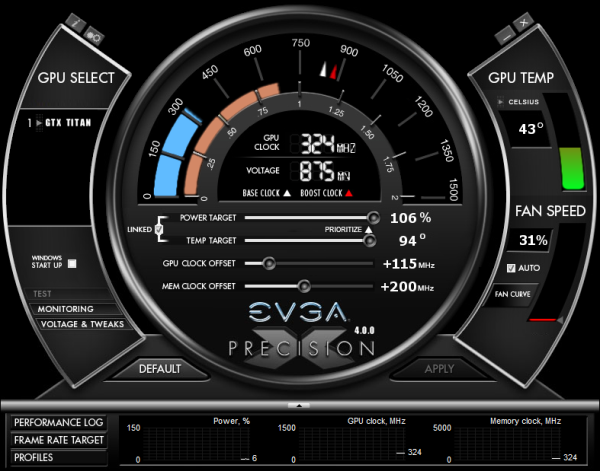NVIDIA’s GeForce GTX Titan Review, Part 2: Titan's Performance Unveiled
by Ryan Smith & Rahul Garg on February 21, 2013 9:00 AM ESTThe Final Word On Overclocking
Before we jump into our performance breakdown, I wanted to take a few minutes to write a bit of a feature follow-up to our overclocking coverage from Tuesday. Since we couldn’t reveal performance numbers at the time – and quite honestly we hadn’t even finished evaluating Titan – we couldn’t give you the complete story on Titan. So some clarification is in order.
On Tuesday we discussed how Titan reintroduces overvolting for NVIDIA products, but now with additional details from NVIDIA along with our own performance data we have the complete picture, and overclockers will want to pay close attention. NVIDIA may be reintroducing overvolting, but it may not be quite what many of us were first thinking.
First and foremost, Titan still has a hard TDP limit, just like GTX 680 cards. Titan cannot and will not cross this limit, as it’s built into the firmware of the card and essentially enforced by NVIDIA through their agreements with their partners. This TDP limit is 106% of Titan’s base TDP of 250W, or 265W. No matter what you throw at Titan or how you cool it, it will not let itself pull more than 265W sustained.
Compared to the GTX 680 this is both good news and bad news. The good news is that with NVIDIA having done away with the pesky concept of target power versus TDP, the entire process is much simpler; the power target will tell you exactly what the card will pull up to on a percentage basis, with no need to know about their separate power targets or their importance. Furthermore with the ability to focus just on just TDP, NVIDIA didn’t set their power limits on Titan nearly as conservatively as they did on GTX 680.
The bad news is that while GTX 680 shipped with a max power target of 132%, Titan is again only 106%. Once you do hit that TDP limit you only have 6% (15W) more to go, and that’s it. Titan essentially has more headroom out of the box, but it will have less headroom for making adjustments. So hardcore overclockers dreaming of slamming 400W through Titan will come away disappointed, though it goes without saying that Titan’s power delivery system was never designed for that in the first place. All indications are that NVIDIA built Titan’s power delivery system for around 265W, and that’s exactly what buyers will get.
Second, let’s talk about overvolting. What we didn’t realize on Tuesday but realize now is that overvolting as implemented in Titan is not overvolting in the traditional sense, and practically speaking I doubt too many hardcore overclockers will even recognize it as overvolting. What we mean by this is that overvolting was not implemented as a direct control system as it was on past generation cards, or even the NVIDIA-nixed cards like the MSI Lightning or EVGA Classified.
Overvolting is instead a set of two additional turbo clock bins, above and beyond Titan’s default top bin. On our sample the top bin is 1.1625v, which corresponds to a 992MHz core clock. Overvolting Titan to 1.2 means unlocking two more bins: 1006MHz @ 1.175v, and 1019MHz @ 1.2v. Or put another way, overvolting on Titan involves unlocking only another 27MHz in performance.

These two bins are in the strictest sense overvolting – NVIDIA doesn’t believe voltages over 1.1625v on Titan will meet their longevity standards, so using them is still very much going to reduce the lifespan of a Titan card – but it’s probably not the kind of direct control overvolting hardcore overclockers were expecting. The end result is that with Titan there’s simply no option to slap on another 0.05v – 0.1v in order to squeak out another 100MHz or so. You can trade longevity for the potential to get another 27MHz, but that’s it.
Ultimately, this means that overvolting as implemented on Titan cannot be used to improve the clockspeeds attainable through the use of the offset clock functionality NVIDIA provides. In the case of our sample it peters out after +115MHz offset without overvolting, and it peters out after +115MHz offset with overvolting. The only difference is that we gain access to a further 27MHz when we have the thermal and power headroom available to hit the necessary bins.
| GeForce GTX Titan Clockspeed Bins | |||
| Clockspeed | Voltage | ||
| 1019MHz | 1.2v | ||
| 1006MHz | 1.175v | ||
| 992MHz | 1.1625v | ||
| 979MHz | 1.15v | ||
| 966MHz | 1.137v | ||
| 953MHz | 1.125v | ||
| 940MHz | 1.112v | ||
| 927MHz | 1.1v | ||
| 914MHz | 1.087v | ||
| 901MHz | 1.075v | ||
| 888MHz | 1.062v | ||
| 875MHz | 1.05v | ||
| 862MHz | 1.037v | ||
| 849MHz | 1.025v | ||
| 836MHz | 1.012v | ||
Finally, as with the GTX 680 and GTX 690, NVIDIA will be keeping tight control over what Asus, EVGA, and their other partners release. Those partners will have the option to release Titan cards with factory overclocks and Titan cards with different coolers (i.e. water blocks), but they won’t be able to expose direct voltage control or ship parts with higher voltages. Nor for that matter will they be able to create Titan cards with significantly different designs (i.e. more VRM phases); every Titan card will be a variant on the reference design.
This is essentially no different than how the GTX 690 was handled, but I think it’s something that’s important to note before anyone with dreams of big overclocks throws down $999 on a Titan card. To be clear, GPU Boost 2.0 is a significant improvement in the entire power/thermal management process compared to GPU Boost 1.0, and this kind of control means that no one needs to be concerned with blowing up their video card (accidentally or otherwise), but it’s a system that comes with gains and losses. So overclockers will want to pay close attention to what they’re getting into with GPU Boost 2.0 and Titan, and what they can and cannot do with the card.











337 Comments
View All Comments
vps - Thursday, February 21, 2013 - link
For compute benchmark you might want to take a look at FAHBenchFAHBench is the official Folding@Home GPU benchmark. It measures the compute performance of GPUs for Folding@Home.
http://proteneer.com/blog/?page_id=1671
Some reference scores are here:
http://foldingforum.org/viewtopic.php?f=38&t=2...
Ryan Smith - Thursday, February 21, 2013 - link
FAHBench is primarily an OpenCL benchmark (there's a CUDA path, but it's effectively on its way out). It's on our list, and is one of the things we couldn't run due to the fact that OpenCL is not currently working on Titan.Hrel - Thursday, February 21, 2013 - link
PowerDirector still uses CUDAatlr - Thursday, February 21, 2013 - link
Not sure if this helps. I found CLBenchmark results of a Titan versus a 7970 here.http://clbenchmark.com/compare.jsp?config_0=144702...
atlr - Thursday, February 21, 2013 - link
Ville Timonen posted results running his own code on a Tesla K20 versus the usual suspects. Might be helpful to folks considering options for GPGPU computation.http://wili.cc/blog/gpgpu-faceoff.html
chizow - Thursday, February 21, 2013 - link
That's the first thing that comes to mind now when I think of Nvidia, which is a shame because that name used to be synonymous with Awesome. That's gone and replaced with a disdain for ridiculous levels of usury with their last two high-end product launches. I'm not going to be disingenuous and claim I'm going AMD, because the fact of the matter is, Nvidia products are still in a class of it's own for my usage needs, but I will certainly not be spending as much on Nvidia parts as I used to.Kepler has basically set back Nvidia's product stack back by half a generation, but my price:performance metrics will stay the same. Nvidia has their ultra-premium "Xtreme Edition" GPU this round, but that only came about as a result of AMD's ridiculous pricing and overall lackluster performance of the 7970 for a "flagship" card. Either way, I think it will be difficult for Nvidia to sustain this price point, as expectations just got higher at that $1K range.
@Ryan: I'm disappointed you didn't write a harsher commentary on the fact Nvidia is now charging 2x for the same class of GPU, pricing that has stayed true since 2006. Even the G80 Ultra didn't approach this $1K mark. Given how many times Nvidia has had to backpedal and apologize about the Ultra's pricing, you would think they would learn from their mistakes. I guess not, I hope they are prepared to deal with the long-term ramifications, backlash, and loss of goodwill stemming from this pricing decision.
CeriseCogburn - Thursday, February 21, 2013 - link
7.1 billion transistors and 6G of ram.I for one am sick of you people constantly whining.
If we check the whine log from the ATI32 days you were doing it then, too.
It's all you people do. Every time, all the time.
chizow - Friday, February 22, 2013 - link
And all you do is post inane, barely intelligible nonsense in defense of Nvidia. If you check your "whine logs" you'll see I've done my fair share of defending Nvidia, but I can't and won't give them a pass for what they've done with Kepler. AMD started it for sure with the terribad price:performance of Tahiti, but Nvidia has taken it to a new level of greed.And for all the idiots who are going to reply "herr dueerr Nvidai need make money not a charity derrr", my advanced reply is that Nvidia has made money in all but 2-3 quarters since 2006 without selling a single $1K desktop GPU. In fact, they enjoyed record profits, margin and revenue on the back of a $250 GPU, the 8800GT in 2007-2008.
CeriseCogburn - Saturday, February 23, 2013 - link
Nope, you are the crying whining baby who says the same thing in 100 different posts here, and has no clue what "the economy" of "the world" has been doing for the past several years.Whatever.
Please go cry about all the other computer part prices that are doing the same thing.
CeriseCogburn - Saturday, February 23, 2013 - link
I mean you idiots want the same price for more perf over a DECADE. Meanwhile, the rest of the worlds pricing has DOUBLED.Now, computer prices used to drop across the board, but they just aren't doing it anymore, and IDIOTS like yourself continue on your stupid frikkin rants, ignoring the world itself, not to mention the LACK of production in that world for the GPU's you whine about. It's really funny how stupid you are.